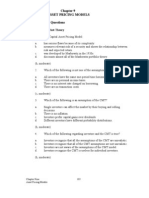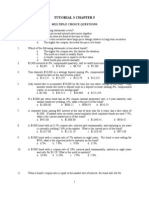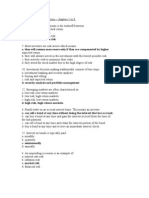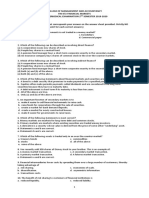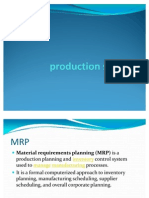Bond Yields and Prices Multiple Choice Questions
Bond Yields and Prices Multiple Choice Questions
Uploaded by
Manuel BoahenCopyright:
Available Formats
Bond Yields and Prices Multiple Choice Questions
Bond Yields and Prices Multiple Choice Questions
Uploaded by
Manuel BoahenOriginal Title
Copyright
Available Formats
Share this document
Did you find this document useful?
Is this content inappropriate?
Copyright:
Available Formats
Bond Yields and Prices Multiple Choice Questions
Bond Yields and Prices Multiple Choice Questions
Uploaded by
Manuel BoahenCopyright:
Available Formats
Chapter 17
BOND YIELDS AND PRICES
Multiple Choice Questions
Bond Yields
1. One percentage point of a bond yield represents:
a. 1 basis point
b. 10 basis points
c. 100 basis points
d. 1000 basis points
(c, easy)
2. Subtracting the inflation rate from the market interest rate results in an
approximate:
a. inflation-adjusted rate of interest
b. real risk-free rate of interest
c. real risky rate of interest
d. inflation-adjusted yield
(b, moderate)
3. For risk-free securities, the nominal interest rate is a function of:
a. actual and expected inflation rates
b. expected inflation rate and expected return
c. real rate of interest and expected inflation rate
d. market rate of return and real rate of interest
(c, moderate)
4. Under the Fisher hypothesis, if a one point increase in the inflation rate is
anticipated:
a. nominal rates on short-term securities would rise by one point.
b. nominal rates on short-term securities would fall by one point.
c. nominal rates on short-term securities would fall by less than one point.
d. nominal rates on short-term securities would rise by less than one point.
(a, moderate)
Chapter Eight 215
Bond Yields and Prices
5. Which of the following regarding the current yield on a bond is not true?
a. The current yield is superior to the coupon rate because it uses market
price instead of face value.
b. The current yield is reported daily in The Wall Street Journal.
c. The current yield does not account for difference between purchase price
and redemption value.
d. The current yield shows the bond’s expected rate of return if held to
maturity.
(d, moderate)
6. The yield to maturity consists solely of interest income if:
a. the bond is a zero coupon bond.
b. the bond was purchased at par.
c. the bond was purchased above par.
d. the bond was purchased below par.
(b, easy)
7. In order to have a yield to maturity greater than the coupon rate, the bond
must be:
a. selling at a discount.
b. selling at par.
c. selling at a premium.
d. a zero coupon bond.
(a, easy)
8. Typically, a yield to call calculation will use:
a. market interest rates rate than the coupon rate.
b. current market price rather than the maturity value.
c. the end of the deferred call period rather than remaining years on the term.
d. all of the above will be used.
(c, moderate)
9. When interest rates rise,
a. bond prices rise.
b. bond prices fall.
c. prices of newly issued bonds are lowered.
d. interest rates of existing bonds are raised.
(b, easy)
Chapter Eight 216
Bond Yields and Prices
10. If a bond is callable, this means:
a. the issuer may change the coupon rate.
b. the investor may convert the bond into stock.
c. the issuer may redeem the bond early.
d. the investor may cash in the bond at any time.
(c, easy)
11. The YTM calculation assumes:
a. reinvestment of interest is at the coupon rate.
b. no reinvestment of interest.
c. reinvestment of interest is at YTM rate.
d. reinvestment of interest is at the risk-free rate.
(c, difficult)
12. The face value of most bonds is:
a. $100
b. $500
c. $1000
d. $10,000
(c, easy)
13. The Fisher hypothesis is an approximation of the
a. risk-free interest rate.
b. real risk-free interest rate.
c. inflation rate.
d. risk premium.
(a, moderate)
14. Bonds with deferred call features
a. can be retired at any time prior to maturity on condition that the issuer
gives notice.
b. can only be retired after a specified period following the date of issue.
c. can be retired at any time, but the issuer will have to pay an additional
premium..
d. generally have no call premium.
(b, moderate)
Chapter Eight 217
Bond Yields and Prices
15. When calculating the yield-to-call on a bond, the stream of interest
payments is __________ and the par value is replaced by the __________.
a. lengthened to the call period . . . call price.
b. shortened to the call period . . . call price.
c. not used in the calculation . . . current market price.
d. shortened to the call period . . . current market price.
(b, moderate)
16. An increase in reinvestment rate risk
a. is caused by an increase in interest rates.
b. leads to a decline in coupon rates.
c. results from a decline in interest rates.
d. results from an increase in inflation.
(c, difficult)
17. The yield-to-call is like the yield-to-maturity except for the
a. coupon payments and maturity value.
b. number of periods to maturity and maturity value.
c. number of periods to maturity and inflation premium.
d. coupon rate and coupon payments.
(d, moderate)
18. The yield to maturity is 8 percent. If the yield increases by 50 basis
points, the new yield is :
a. 8.005 percent.
b. 8.050 percent.
c. 8.500 percent.
d. 13.000 percent.
(c, moderate)
19. A bond is selling at a discount if the:
a. yield-to-maturity is greater than the coupon rate.
b. yield-to-maturity is less than the coupon rate.
c. market price is greater than the par value.
d. yield-to-call is less than the coupon rate.
(a, moderate)
Chapter Eight 218
Bond Yields and Prices
20. The real rate of interest is almost always:
a. the opportunity cost of foregoing consumption.
b. greater than the nominal rate of interest.
c. equal to the nominal rate of interest.
d. easily affected by risk factors.
(a, moderate)
21. The __________ equates the present value of the total future dollars
expected to be available at the end of a specific time period, given certain
assumptions, to the price of the bond.
a. horizon return
b. promised return
c. expected return
d. coupon return
(a, moderate)
22. Find the price of a 10 percent coupon bond with three years to maturity if
the yield to maturity is now 12 percent. Use semiannual discounting.
a. $1196.70 Solution: Use 6 percent and 6 periods
b. $950.85 Price = 50(4.917) + 1000(0.705)
c. $952.20 = 950.85
d. $999.80
(b, difficult)
23. The YTM for a zero-coupon bond with 10 years to maturity and selling for
$450 is
a. 9.00 percent. Solution: YTM = [MV/P]1/2n - 1
b. 8.15 percent. = [1000/450]1/20 – 1
c. 2.22 percent. = 0.04733 per half year
d. 4.07 percent. YTM = 0.04733(2) = 0.0815
(b, difficult)
Chapter Eight 219
Bond Yields and Prices
24. If bond investors do not reinvest the coupons received during the life of
the bond, then the
a. RCY will be less than the YTM.
b. RCY will exceed the YTM.
c. nominal yield will be greater than the YTM.
d. current yield will equal the YTM.
(b, difficult)
25. Reinvestment rate risk increases with a ________ coupon rate and a
________ term to maturity.
a. low . . . short
b. low . . . long
c. high . . . long
d. zero . . . short
(c, moderate)
26. Which of the following statements regarding the realized compound yield
(RCY) is true?
a. The RYC will always be higher than the YTM.
b. The RYC will always be lower than the YTM.
c. The RYC does not assume coupons are reinvested at the YTM.
d. The RYC assumes price is below par.
(c, moderate)
Bond Prices
27. Which of the following statements regarding changes in bond prices
relative to changes in market yields is true?
a. Short-term bond prices will increase more than long-term bond prices if
market yields increase.
b. Short-term bond prices will increase less than long-term bond prices if
market yields decrease.
c. Short-term bond prices will increase more than long-term bond prices if
market yields decrease.
d. Short-term bond prices will remain constant and long-term bond prices
will increase if market yields decrease.
(b, difficult)
Chapter Eight 220
Bond Yields and Prices
28. Which of the following bonds would you expect to have the greatest price
volatility?
a. 10%, 10 year bond
b. 10%, 5 year bond
c. 5%, 10 year bond
d. 5%, 5 year bond
(c, difficult)
29. Which of the following statements about the risk premium affecting
market interest rates is FALSE? The risk premium
a. is often referred to as the yield differential.
b. is the compensation required for the risk involved.
c. can be zero.
d. is not associated with the issuer's own particular situation.
(d, difficult)
Bond Price Changes
30. All other factors constant, the -------------- of a bond, the shorter the
duration.
a. longer the term
b. higher the coupon rate
c. higher the risk
d. higher the rating
(b, moderate)
31. Duration can be used to:
a. minimize default risk
b. minimize reinvestment risk.
c. minimize interest rate risk.
d. maximize return.
(c, moderate)
Chapter Eight 221
Bond Yields and Prices
32. The duration of a zero coupon bond:
a. is less than its term.
b. is equal to its term.
c. is greater than its term.
d. is impossible to determine.
(b, easy)
33. Duration is based upon:
a. future value concepts.
b. compound interest.
c. present value concepts.
d. the Fisher hypothesis.
(c, moderate)
34. Which of the following statements about bond prices is FALSE?
a. Bond price volatility and time to maturity are directly related.
b. A decrease in yields raises prices more than an increase in yields lowers
prices.
c. Bond price fluctuations and bond coupons are directly related.
d. Bond prices move inversely to bond yields.
(c, difficult)
35. Maturity constant, increases in interest rates ___ bond prices by
proportionately __ amounts than decreases in rates ___ bond prices.
a. increase . . . smaller . . . increase
b. decrease . . . smaller . . . increase
c. decrease . . . larger . . . increase
d. increase . . . larger . . . decrease
(b, difficult)
36. Convexity is important in bond analysis because
a. the price-yield relationship is imprecise.
b. the relationship between bond maturity and interest rate changes is
convex.
c. the relationship between bond price changes and duration is an
approximation.
d. bonds have a convex relationship with duration.
(c, moderate)
Chapter Eight 222
Bond Yields and Prices
37. Convexity is largest for bonds with _________ coupons, ________
maturities, and ________ yields to maturity.
a. low . . . long . . . low
b. high . . . long . . . low
c. low . . . short . . . low
d. high . . . short . . . high
(a, difficult)
38. Which of the following bond relationships is NOT inverse?
a. Coupon and duration
b. Duration and yield to maturity
c. Interest rate changes and bond prices
d. Duration and maturity
(d, difficult)
39. Duration tells us the
a. actual price volatility from a bond.
b. stated life of a bond.
c. weighted average maturity of a bond.
d. true rate of return to be earned on a bond.
(c, moderate)
40. For all bonds paying coupons, duration is
a. less than maturity.
b. greater than maturity.
c. about equal to maturity.
d. not related to maturity.
(a, easy)
41. With regard to duration, choose the INCORRECT statement.
a. Duration expands with time to maturity but at a decreasing rate.
b. Yield to maturity is directly related to duration.
c. Coupon is inversely related to duration.
d. Duration is a measure of bond price sensitivity to interest rate movements.
(b, moderate)
Chapter Eight 223
Bond Yields and Prices
True-False Questions
Bond Yields
1. Treasury bonds are typically used a proxy for the short-term riskless rate.
(F, moderate)
2. The real risk-free rate of interest is the rate that must be offered to
persuade individuals to invest rather than save.
(F, difficult)
3. If the current yield is above the coupon rate, the bond is selling at a
premium.
(F, easy)
4. If two bonds have the same coupon rate and the same term, they will have
the same intrinsic value.
(F, moderate)
5. The horizon return is the bond return to be earned based on assumptions
about reinvestment rates.
(T, moderate, p. 458)
Bond Prices
6. In bond valuation, the appropriate discount rate is the required yield.
(T, moderate)
7. The higher the discount rate used in bond valuation, the lower the bond’s
intrinsic value.
(T, easy)
Bond Price Changes
8. Duration measures the weighted average maturity of a noncallable bond’s
cash flows on a present value basis.
(T, difficult)
Chapter Eight 224
Bond Yields and Prices
9. Duration expands with time to maturity at an increasing rate.
(F, difficult)
10. The term used to describe the degree to which duration changes as the
yield to maturity changes is linearity.
(F, moderate)
Short-Answer Questions
Bond Yields
1. What is the reinvestment rate assumption in regard to the yield to
maturity?
(moderate)
Answer: That all receipts of coupon payments are reinvested at the yield to
maturity.
2. Why is the yield to call a more appropriate measure to use for callable
bonds with high coupons rather than the yield to maturity?
(moderate)
Answer: High coupon bonds face a greater chance of being called than low
coupon bonds so investors will more likely to receive the yield to
call than the yield to maturity.
Bond Price Changes
3. What weakness of modified duration does convexity correct?
(moderate)
Answer: Modified duration predictions are linear approximations.
Convexity corrects the answer for the curvature of the price
function.
4. Why does the coupon rate affect the volatility of bond price?
(difficult)
Answer: The higher the coupon rate and payment, other things the same, the
more of the bond’s value comes from the coupon payments and the
less from the maturity value. The coupon payments are received
Chapter Eight 225
Bond Yields and Prices
sooner than the maturity value, and, therefore, are affected less by
compounding.
5. For each of the following variables, state whether duration has a direct or
inverse relationship: term to maturity, size of coupon payment, yield to
maturity.
(difficult)
Answer: Term to maturity – direct; size of coupon payment - inverse; yield
to maturity - inverse.
6. How does value of a bond change as it nears its maturity?
(moderate)
Answer: Bond prices will change so that the bond will be worth its face
value on the maturity date.
Critical Thinking/Essay Questions
1. How can duration and convexity assist the portfolio manager in assessing
the interest-rate risk inherent in a bond portfolio?
(difficult)
Answer: The greater the duration and convexity, the greater the interest-rate
risk. Since interest-rate risk is a major source of systematic risk,
this makes the portfolio manager's job easier.
2. What are three reasons that duration is important in bond analysis and
management?
(moderate)
Answer: (a) It measures effective lives of alternative bonds.
(b) It is used in bond management strategies.
(c) It measures bond price sensitivity to interest rate changes.
Problems
1. A 10-year, $1000 corporate bond with a 10 percent coupon rate (interest is
paid semi-annually) is currently selling for $850:
(a) Calculate its current yield.
(b) Calculate its yield to maturity (using a financial calculator)
Chapter Eight 226
Bond Yields and Prices
(moderate)
Solution: (a) current yield = coupon______
current market price
= 100/850 = 11.76 percent
(b) = 2 pmts per year, 1000 FV, -850 PV, 20 N, 50 pmt, solve for
interest rate = 12.69 percent
2. Two 10 percent coupon bonds are selling at par. Bond A has a 15 year
maturity and Bond B has a 25 year maturity. If the appropriate required
rate of return for these two bonds drops to 8 percent, calculate the
percentage change in the price of each bond, using a financial calculator.
Assume interest is paid semi-annually.
(difficult)
Solution: Bond A = original price = $1,000; new price = 1000 FV, 8 interest
rate, 50 pmt, 30 N, solve for PV = $1,172.92
Percentage change in price = 1172.92 - 1000
1000 = .1179 = 11.79%
Bond B = original price = $1,000; new price = 1000 FV, 8 interest
rate, 50 pmt, 50 N, solve for PV = $1,214.82
Percentage change = 1214.82 - 1000
1000 = .2148 = 21.48%
3. Calculate the duration of a bond with a 7 percent coupon and a 3-year
maturity currently priced at $1,000. Interest is paid annually.
(difficult)
Solution:
Year Cashflow Present Value PV of CF PV/ Price Year X PV/Price
1 $70 .9346 $65.42 .065 .065
2 $70 .8734 $61.14 .061 .122
3 $1070 .8163 $873.44 .873 2.619
$1000 2.806 years
Chapter Eight 227
Bond Yields and Prices
You might also like
- CFA Level 1 Calculation Workbook: 300 Calculations to Prepare for the CFA Level 1 Exam (2024 Edition)From EverandCFA Level 1 Calculation Workbook: 300 Calculations to Prepare for the CFA Level 1 Exam (2024 Edition)Rating: 4.5 out of 5 stars4.5/5 (5)
- SIE Exam Practice Question Workbook: Seven Full-Length Practice Exams (2024 Edition)From EverandSIE Exam Practice Question Workbook: Seven Full-Length Practice Exams (2024 Edition)Rating: 5 out of 5 stars5/5 (1)
- Series 65 Exam Practice Question Workbook: 700+ Comprehensive Practice Questions (2024 Edition)From EverandSeries 65 Exam Practice Question Workbook: 700+ Comprehensive Practice Questions (2024 Edition)No ratings yet
- CSC Vol 1 Test 1 VB With SolutionsDocument7 pagesCSC Vol 1 Test 1 VB With Solutionschris100% (1)
- Artificial Intelligence For HRDocument241 pagesArtificial Intelligence For HRSrWhiteNo ratings yet
- CPAR Cost of CapitalDocument12 pagesCPAR Cost of CapitalCarlito B. BancilNo ratings yet
- TB CHDocument19 pagesTB CHmuhammad qasimNo ratings yet
- Worksheet For BondsDocument12 pagesWorksheet For BondsvishalNo ratings yet
- CH 05Document13 pagesCH 05Mahmoud HamedNo ratings yet
- Fin 221: Sample MCQ - Chapter 5Document2 pagesFin 221: Sample MCQ - Chapter 5amalia izzatiNo ratings yet
- MCQ5Document2 pagesMCQ5Nadiah NazeirNo ratings yet
- CH 09Document14 pagesCH 09Salman ZafarNo ratings yet
- MCQsDocument49 pagesMCQsTRANG NGUYỄN THUNo ratings yet
- ĐTTC Duy LinhDocument21 pagesĐTTC Duy LinhThảo LêNo ratings yet
- Chapter 12Document13 pagesChapter 12Abood Alissa100% (1)
- ĐTTCDocument38 pagesĐTTCVũ Phương DungNo ratings yet
- CH 9Document5 pagesCH 9bsodoodNo ratings yet
- TN DTTCDocument40 pagesTN DTTC050609211552No ratings yet
- ETS Finance Review QuizDocument4 pagesETS Finance Review QuizRaine PiliinNo ratings yet
- Banking - Old Exam 3 Questions SolutionsDocument10 pagesBanking - Old Exam 3 Questions SolutionsWilmar AbriolNo ratings yet
- Chapp 8Document13 pagesChapp 8TRUC.NT1874 2151874100% (1)
- CH 06Document14 pagesCH 06Mahmoud HamedNo ratings yet
- Finance Bis Mcqs & Tf5Document1 pageFinance Bis Mcqs & Tf5Souliman MuhammadNo ratings yet
- Chaps567 MCQ ReviewerDocument3 pagesChaps567 MCQ Reviewerdaniellejueco1228No ratings yet
- Answer:: Chapter 08: Bond Valuation and RiskDocument14 pagesAnswer:: Chapter 08: Bond Valuation and RiskAS SANo ratings yet
- Tutorial - 3Document4 pagesTutorial - 3danrulz18No ratings yet
- Risk and Return: Name: - Grade and SectionDocument2 pagesRisk and Return: Name: - Grade and SectionWilhelmina L. RomanNo ratings yet
- 8230 Sample Final 1Document8 pages8230 Sample Final 1lilbouyinNo ratings yet
- Interest Rate and Bond ValuationDocument15 pagesInterest Rate and Bond ValuationHaley James ScottNo ratings yet
- 3E Intermediate2 (Tue - 5-11-2024) - Final Ch.2Document24 pages3E Intermediate2 (Tue - 5-11-2024) - Final Ch.2ahmedNo ratings yet
- Example Questions Finance 2016-2017Document6 pagesExample Questions Finance 2016-2017comllikNo ratings yet
- IA MIDTERMS (THEORIES) ReviewerDocument10 pagesIA MIDTERMS (THEORIES) ReviewerelaizaganganiNo ratings yet
- Mock Cfe Fin072Document4 pagesMock Cfe Fin072lancelotroyal21No ratings yet
- Weekly Quiz 2Document30 pagesWeekly Quiz 2Emmmanuel ArthurNo ratings yet
- Possible Mid-Term QuestionsDocument10 pagesPossible Mid-Term QuestionsZobia JavaidNo ratings yet
- Mcqs Help FahadDocument7 pagesMcqs Help FahadAREEBA ABDUL MAJEEDNo ratings yet
- Fin 072 Midterm ExamDocument10 pagesFin 072 Midterm ExamGargaritanoNo ratings yet
- CH 06Document13 pagesCH 06Efrén Barreto100% (1)
- Assignment Sw#1 Mod3 Return & Risk Multiple Choice ADocument6 pagesAssignment Sw#1 Mod3 Return & Risk Multiple Choice AAra FloresNo ratings yet
- Accounting and Finance For Bankers - JAIIBDocument19 pagesAccounting and Finance For Bankers - JAIIBAyesha BepariNo ratings yet
- Valuation of Debt Contracts and Their Price Volatility Characteristics Questions See Answers BelowDocument7 pagesValuation of Debt Contracts and Their Price Volatility Characteristics Questions See Answers Belowevivanco1899No ratings yet
- Fin333 Secondmt04w Sample QuestionsDocument10 pagesFin333 Secondmt04w Sample QuestionsSara NasNo ratings yet
- Textbook SolutionsDocument5 pagesTextbook Solutionsamersyasin17No ratings yet
- CF2 1Document11 pagesCF2 1COPY PAPAGAJKANo ratings yet
- Exercise 6 - 1 Multiple Choice QuestionsDocument2 pagesExercise 6 - 1 Multiple Choice QuestionsJellai TejeroNo ratings yet
- Chapter 4 Practice TestDocument11 pagesChapter 4 Practice TestGresa KodraNo ratings yet
- Review Extra CreditDocument8 pagesReview Extra CreditMichelle de GuzmanNo ratings yet
- Quiz Chapter 3 Bonds Docx CompressDocument7 pagesQuiz Chapter 3 Bonds Docx CompressKurumi KunNo ratings yet
- Risk ManagementDocument14 pagesRisk ManagementHuỳnh Thị MỹNo ratings yet
- Prelim Exam - For PrintingDocument4 pagesPrelim Exam - For PrintingThat's FHEVulousNo ratings yet
- Common Stock Valuation Multiple Choice QuestionsDocument18 pagesCommon Stock Valuation Multiple Choice Questionssamuel kebede100% (1)
- MCQ Reviewers Ia 2Document13 pagesMCQ Reviewers Ia 2Angely MulaNo ratings yet
- Full Name of Our Finance 33 ProfessorDocument3 pagesFull Name of Our Finance 33 ProfessorLhadii LeiNo ratings yet
- Chapter Two Investment Alternatives Multiple Choice QuestionsDocument13 pagesChapter Two Investment Alternatives Multiple Choice QuestionsHashmi SutariyaNo ratings yet
- Economics Homework HelpDocument25 pagesEconomics Homework HelpLucas MillerNo ratings yet
- For CompletionDocument5 pagesFor CompletionMary Angelie De MesaNo ratings yet
- 1 Which of The Following Statements Concerning Bonds Is IncorrectDocument2 pages1 Which of The Following Statements Concerning Bonds Is IncorrectAmit PandeyNo ratings yet
- Mock Test 1Document24 pagesMock Test 1swati shuklaNo ratings yet
- Quiz Multiple Choice P1Document6 pagesQuiz Multiple Choice P1Anna Liza SelausoNo ratings yet
- Contemporary Financial Management 13th Edition Moyer Test Bank 1Document35 pagesContemporary Financial Management 13th Edition Moyer Test Bank 1carlo100% (52)
- FPQP Practice Question Workbook: 1,000 Comprehensive Practice Questions (2024 Edition)From EverandFPQP Practice Question Workbook: 1,000 Comprehensive Practice Questions (2024 Edition)No ratings yet
- Understanding Financial Management: A Practical Guide: Problems and AnswersDocument9 pagesUnderstanding Financial Management: A Practical Guide: Problems and AnswersManuel BoahenNo ratings yet
- Optimization Tutorial QuestionsDocument5 pagesOptimization Tutorial QuestionsManuel BoahenNo ratings yet
- Finance 261 Tutorial Week 6Document4 pagesFinance 261 Tutorial Week 6Manuel BoahenNo ratings yet
- Understanding Financial Management: A Practical Guide: Guideline Answers To The Concept Check QuestionsDocument15 pagesUnderstanding Financial Management: A Practical Guide: Guideline Answers To The Concept Check QuestionsManuel BoahenNo ratings yet
- Understanding Financial Management: A Practical Guide: Guideline Answers To The Concept Check QuestionsDocument11 pagesUnderstanding Financial Management: A Practical Guide: Guideline Answers To The Concept Check QuestionsManuel BoahenNo ratings yet
- Assignment 1Document1 pageAssignment 1Manuel BoahenNo ratings yet
- Chapter 5: International Trade TheoryDocument2 pagesChapter 5: International Trade TheoryManuel BoahenNo ratings yet
- Cailin Chen Question 9: (10 Points)Document5 pagesCailin Chen Question 9: (10 Points)Manuel BoahenNo ratings yet
- Corporate Finance Tutor Ps 5Document2 pagesCorporate Finance Tutor Ps 5Manuel BoahenNo ratings yet
- Understanding Financial Management: A Practical Guide: Guideline Answers To The Concept Check QuestionsDocument9 pagesUnderstanding Financial Management: A Practical Guide: Guideline Answers To The Concept Check QuestionsManuel BoahenNo ratings yet
- FINAL Financial Accounting Priciples WednesdayDocument4 pagesFINAL Financial Accounting Priciples WednesdayShamun ZiaNo ratings yet
- Guidelines For Application of The Petroleum Resources Management SystemDocument30 pagesGuidelines For Application of The Petroleum Resources Management SystemRafael MorenoNo ratings yet
- MGI Affordable Housing Full Report October 2014Document212 pagesMGI Affordable Housing Full Report October 2014Juan José Gallo MejíaNo ratings yet
- Ca Foundation Accounts TheoryDocument90 pagesCa Foundation Accounts TheoryFREEFIRE IDNo ratings yet
- Khaled Mahmud: Myopia & MalpracticeDocument30 pagesKhaled Mahmud: Myopia & MalpracticeM. G. MostofaNo ratings yet
- Made in America: Business PlanDocument44 pagesMade in America: Business Planapi-298226836No ratings yet
- Math1010 Week 01Document10 pagesMath1010 Week 01harshNo ratings yet
- Entrepreneurship in The PhilippinesDocument7 pagesEntrepreneurship in The Philippinesjoanne rivera100% (1)
- Alternative Public Offerings: What Companies Need To Know: Barry I. Grossman, Esq. Ellenoff Grossman & Schole LLPDocument20 pagesAlternative Public Offerings: What Companies Need To Know: Barry I. Grossman, Esq. Ellenoff Grossman & Schole LLPRohan TrivediNo ratings yet
- IBM Commissionaire OverviewDocument13 pagesIBM Commissionaire OverviewSamik Biswas100% (1)
- Prepare and Process Financial DocsDocument47 pagesPrepare and Process Financial DocsEphraim Pryce100% (1)
- Carrefour Q3 2023 Presentation 2Document18 pagesCarrefour Q3 2023 Presentation 2delidrokieuNo ratings yet
- Case Studies in Finance AnalysisDocument4 pagesCase Studies in Finance AnalysisSaad HassanNo ratings yet
- ABM Applied Economics CGDocument7 pagesABM Applied Economics CGJezreel Raizon P. CavalesNo ratings yet
- STP Formatting Guide 010707Document2 pagesSTP Formatting Guide 010707yeuhqhNo ratings yet
- Accounting Standard IndiaDocument114 pagesAccounting Standard IndiakprakashmmNo ratings yet
- Authority and ResponsibilityDocument19 pagesAuthority and ResponsibilityAparna100% (1)
- Insy1012 U4Document48 pagesInsy1012 U4Misbah AbebeNo ratings yet
- Internship Report On "Discussion On Seven Best Practices of Successful Organization & Biman Bangladesh Airlines Limited"Document47 pagesInternship Report On "Discussion On Seven Best Practices of Successful Organization & Biman Bangladesh Airlines Limited"Hossain NomanNo ratings yet
- HRM Short NotesDocument5 pagesHRM Short NotesTitus ClementNo ratings yet
- WEF ScenariosSeries Mongolia Report 2014Document42 pagesWEF ScenariosSeries Mongolia Report 2014Odla Sedlej OcopihcNo ratings yet
- Rule Summary Text Tariff: Market CXR: Ga Rule: IdgsDocument13 pagesRule Summary Text Tariff: Market CXR: Ga Rule: IdgsgarudapkuNo ratings yet
- One World Media - Publications - FacebookDocument7 pagesOne World Media - Publications - FacebookJMNo ratings yet
- Lecturer-Led Tutorial Chapter 5 (2023)Document9 pagesLecturer-Led Tutorial Chapter 5 (2023)Ncebakazi DawedeNo ratings yet
- Corporate RestructuringDocument13 pagesCorporate RestructuringAbdul Ghaffar AbbassiNo ratings yet
- CT Far270 Dec21Document5 pagesCT Far270 Dec212022624622No ratings yet
- MRP & JitDocument21 pagesMRP & JitVismay ViholNo ratings yet
- Employee Retention Project ReportDocument5 pagesEmployee Retention Project Reportpintupal2008No ratings yet
- Highlights - Economy, Policy, Tax - Union Budget 2024Document7 pagesHighlights - Economy, Policy, Tax - Union Budget 2024ashanclent21No ratings yet











